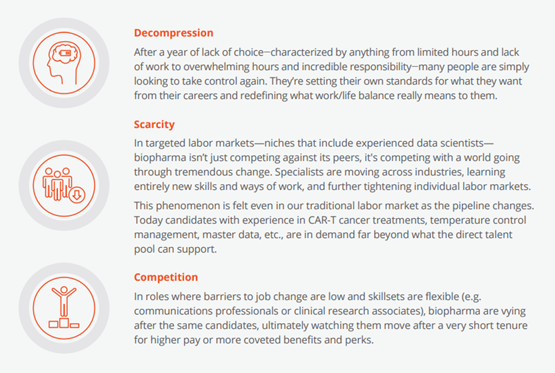1. Strategic outsourcing
Certainly outsourcing is a critical part of the discussion during any talent crisis. Partners are well positioned to have deep pipelines of prequalified candidates to speed time to impact. But, more importantly, many have mature internal growth programs designed to effectively and efficiently train junior talent into more sophisticated and high-impact roles, ultimately protecting against fast spiraling salary costs while delivering the needed business impact
2. Investments in skills, leadership and life
Biopharma and its partners are looking closely at all of the satisfiers of work environments, from a culture people want to be a part of to a challenge opportunity someone never expected to get. In 2022, look for more leadership accelerator programs, deep investment in culture and connectivity, and unique benefits, like work-from-home child care, more flexibility in both location and time, and collective mental health days.
3. Betting on technology and change
As one CEO recently said, there simply aren’t enough humans. As data and personalization become complex, some companies are looking ahead to automation and investing heavily in what can be done without human intervention. Cell and gene innovators like Cellares, Ori Biotech, Avrobio and Cytiva are all advancing automation platforms25 that reduce the need for talent in the cell and gene process. Other shifts will be broader. Over the next 3-5 years, some of today’s talent sourcing challenges will likely be attenuated by other industry trends. For example, the current shortage of experienced clinical research associates will likely be improved as decentralized trial technologies become more frequently used.
4. Building a future-ready pipeline
There are no shortages of stories decrying the exodus of talent from healthcare. Pharmacists have been added to the Home Office’s shortage occupation26 list in the UK. A global nursing shortage27 is threatening all of healthcare delivery. In biopharma particularly, we’ve watched the clinical research associate gap grow since 2016 and now a new hole is opening in regulatory affairs. Furthermore, it’s happening early. Recent research28 by Drs. Frances Richmond and Terry Church at the University of Southern California found that the number of qualified participants enrolling in relevant graduate training programs is declining, particularly worrying as the projected needs of biopharma for regulatory are increasing. Leaders in the industry are actively watching these trends and mapping gaps a decade or more in advance. They’re investing in graduate training programs, recruiting efforts and university partnerships to ensure that, for example, the 70,000 regulatory roles that will need to be filled in the next ten years have rich talent pools.





